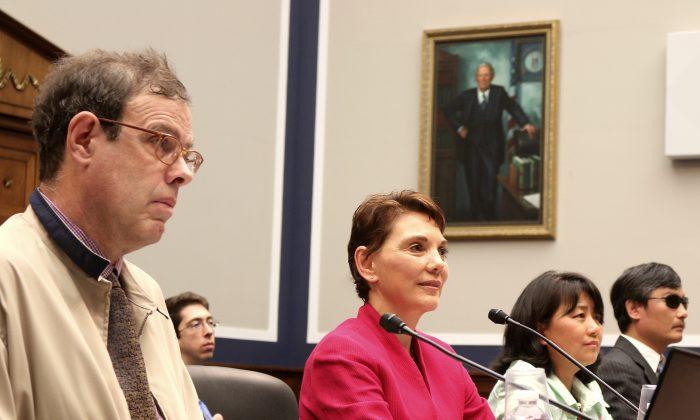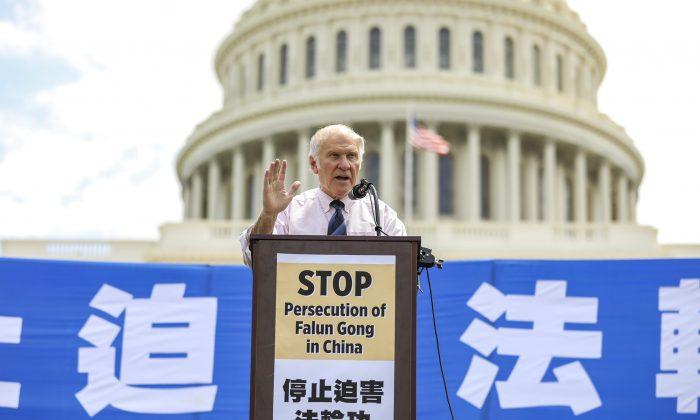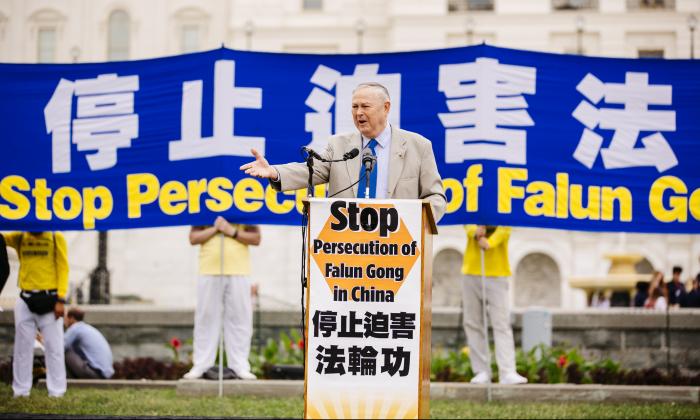WASHINGTON—Just over a year ago, China modified its “One Child Policy” to allow couples to have two children when one of the parents is an only child.
The change was not a major reform and by no means meant that the policy was on its way out. The main coercive features were left untouched, according to the testimony given April 30, at the Congressional Executive Commission on China (CECC).
“Left unchanged was the Chinese government’s strangle-hold on deciding who can have children, when they can have children, and how many children a family can have,” said Congressman Christopher Smith (R-N.J.), who chairs the commission.
Reggie Littlejohn, founder and president of Women’s Rights Without Frontiers, said it left in place the “dreaded ‘birth intervals’ between children. If a woman gets pregnant before the interval has lapsed, she risks forced abortion.”
Littlejohn said that “tweaking” the policy to allow two children does not address the core issue of human rights. “The CCP [Chinese Communist Party] is telling women how many children they can have and then enforcing that limit through forced abortion and forced sterilization. … Women who get pregnant without permission will still be dragged out of their homes, strapped down to tables, and forced to abort babies [that they want].”
‘River of Blood’
Present at the CECC hearing was the blind Chinese lawyer Chen Guangcheng, who while in China challenged the abuses of population planning officials, including forced abortions and sterilizations. After serving a sentence of four years and three months, he and his family were placed under virtual house arrest. Chen managed to escape his captors in 2012 and came to the United States with his family.
Chen read some official slogans from provinces, which reveal the bloody and brutal violence emanating from China’s birth control practices.
In Jiangsu: “We'd rather see a river of blood than a single [unauthorized] baby born alive.”
In Anhui: “We'd rather see ten more tombs than a single baby born alive.”
In Sichuan: “Anyone avoiding sterilization must be put in custody. Anyone avoiding sterilization must be punished by bulldozing their house. Anyone avoiding abortion shall surrender their cattle and house.”
In Yunnan, “All villagers must be sterilized once a single villager violates the birth quota.”
Chen testified that a married couple must obtain a permit from the local birth control committee before pregnancy. If the woman is pregnant without the permit, the woman is summoned to a local birth control station and coerced into signing a consent form for an abortion. If she has not had the operation—perhaps she went into hiding—the committee takes away family members, relatives, and even neighbors, usually 10 to 20 households, by force.
The enforcement is brutal. Chen described his hometown where one could hear and see from a dozen to several dozen people, headed by local party chiefs, beating villagers, acting like lawless bandits. He described “screaming and crying” during these operations. Chen said these illegal detentions cause a lot of strife and even hatred among relatives.
Chen’s description of the forced abortion is too graphic to describe in detail here. In late pregnancies, birth is induced and the fetus drowned in a water bucket. “Sometimes a doctor would break the neck of a baby and throw it into a trash bin,” Chen said.
“This brutality and these crimes against women and their families have wrought irrevocable physical, spiritual, and psychological harm. Many families have lost hope and end up broken,” he said.
Moreover, he said that a one-child family can be harmful for the child. “An old Chinese saying goes, a single piece of wood burns hardly long. So it is hard to raise a single child in a family. These so-called little emperors and little princesses exhibit a selfish character and a weak and fragile psyche.”
The One-Child policy began on Sept. 25, 1980 as a population control measure when the average fertility was 5.9 children per woman. In the nearly 35 years, “China has killed a total of 360 to 400 million young lives as a result of its inhumane and violent birth control policies,” Chen said. The communist regime regularly boasts 400 million—a number that exceeds the population of the United States.
Chai Ling, founder of “All Girls Allowed,” said that when she first heard about “one child per family,” it sounded “benign and perfect.” But later she came to realize, “the true nature of this policy was that all other children must die.”
Demographic Disaster
The One-Child policy, combined with preference for sons, condemned millions of Chinese girls, deemed “surplus” by the policy, to “abortion, infanticide, and abandonment,” said U.S. Senator Marco Rubio, co-chair of the CECC, in a statement submitted for the record. Rubio said that the skewed sex ratio is out of kilter, resulting in 30 million more men than women by 2020, according to the Chinese regime’s own estimates.
Smith said not just the Chinese regime but the world should be concerned at the consequences of 30 million men unable to marry and have families at the same time that China’s economy is slowing down.
Rubio and Smith each said to expect increases in human trafficking for purposes of prostitution and forced marriages. NGOs in China’s neighbors Vietnam, Cambodia, and Burma are reporting increases in trafficking of women and girls into China, said Smith. Rubio stressed the likely impact of a large number of “involuntary bachelors” will have on “internal social unrest and broader regional stability.”
Further, limiting the population growth doesn’t make economic sense. By 2025, nearly 1 in 4 Chinese citizens will be over the age of 60, said Smith, citing a recent report in the Economist. A shrinking working population will hurt economic growth, the primary source of the regime’s legitimacy, he said.
Littlejohn said that a policy designed for reducing the population size no longer applies. The fertility rate has fallen from 5.9 in 1980 to 1.5, far below the replacement level of 2.1. The problem now is “too few young people and too few women.”
Smith said he was frankly baffled why the China regime would want to continue its “brutal policy of population control.”

Looking for a motive for the irrational policy, Littlejohn noted that it was “enormously profitable for the CCP.” One estimate she cited from the Economist in 2012, said that the accumulated fines for having extra children summed to 2 trillion yuan ($314 billion) since 1980.
Effect of One-Child Policy on Demography Overstated?
The American Enterprise Institute’s Nicholas Eberstadt, who has numerous publications on demographics in East Asia, disagreed with attributing to a one-child or two-child policy the main cause of future demographic disasters.
Eberstadt said that although “estimating the net demographic impact of China’s police-state population policy” is difficult to do, he was convinced that coercive policies are not a necessary condition for a highly skewed sex ratio.
The normal sex ratio at birth (SRB) is 103-105 on established human populations, he said. Based on officially reported census figures, sex selection abortion for first pregnancies was not common in the 1990s and early 2000s, when infanticide was rampant. But this factor has changed in recent years. The SRB for first births was nearly 114 boys for every 100 girls according to the 2010 census. Now the sex-selection method of choice is by aborting the girl fetuses.
Dr. Eberstadt said that biologically abnormal distortions of the SRB occur without the involuntary population control policies like China’s.
“Unnaturally high SRBs today are witnessed in culturally Chinese settings like Hong Kong and Taiwan, in parts of India and Pakistan, and in West Asian countries such as Georgia and Armenia. None of these countries maintains a forcible birth control policy.”
To explain the unnaturally high sex ratio at birth, Dr. Eberstadt laid great emphasis on the enduring power of the son preference in China combined with the universal availability of prenatal gender detection technology. However, he thinks that to the extent that the One-Child Policy and its attendant low fertility provide fewer chances for a couple to have a son, abnormal SRBs are bound to be greater than would otherwise occur.





Friends Read Free